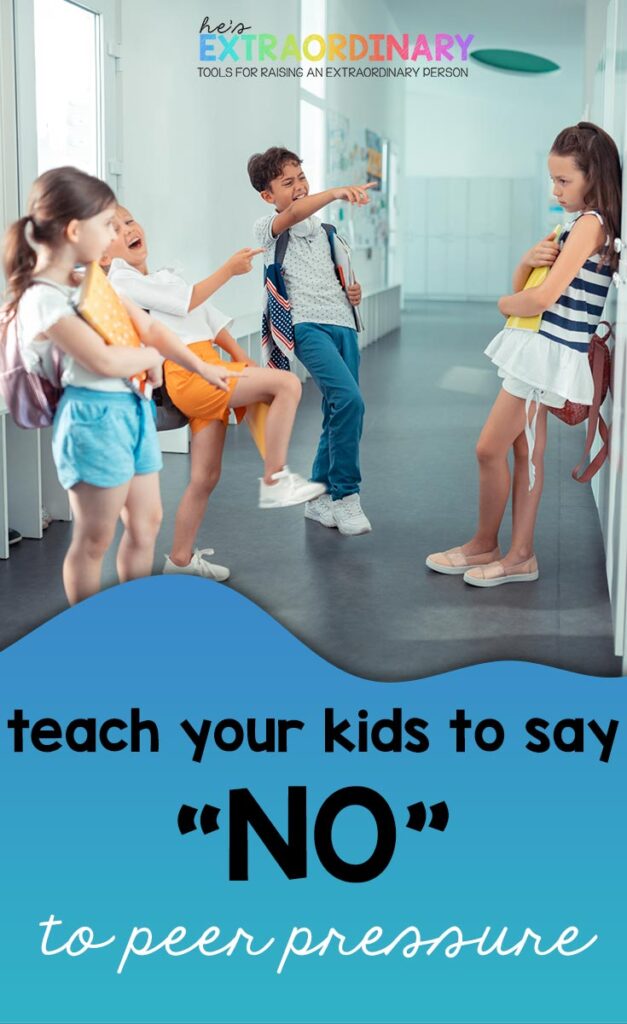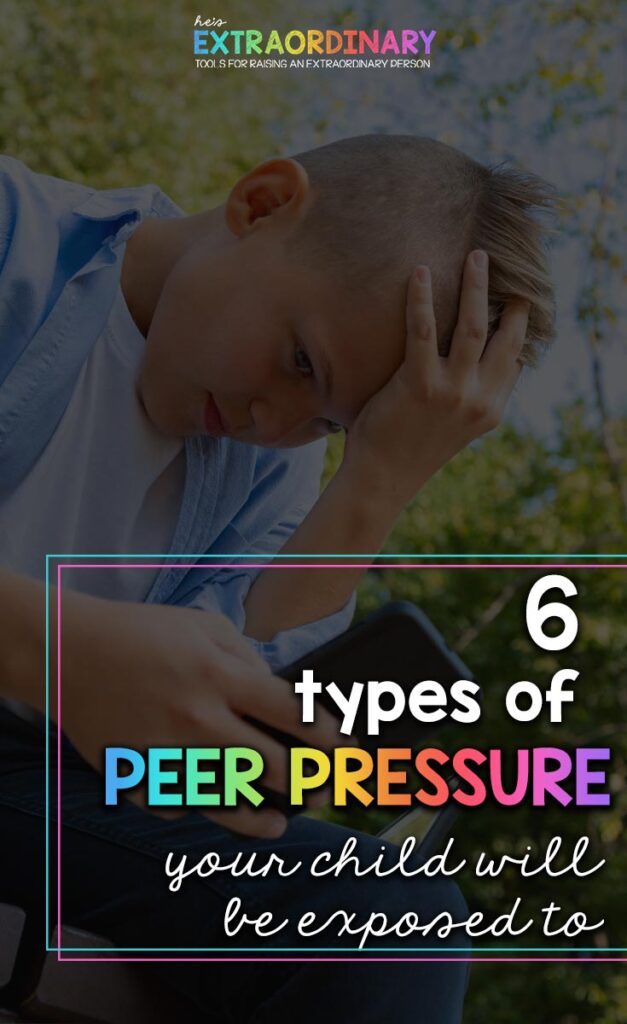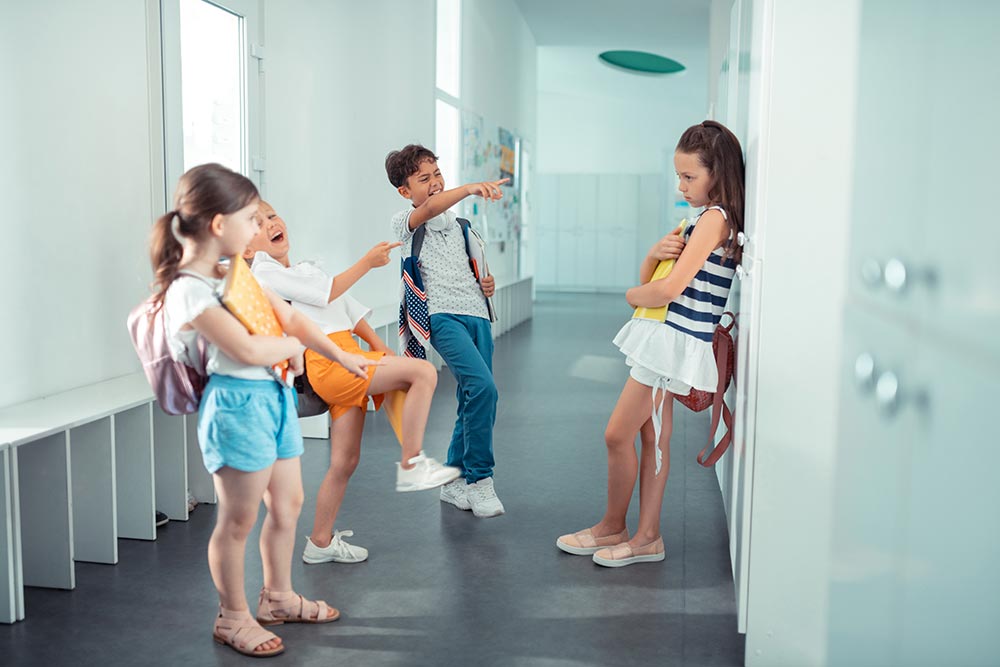Teaching Kids to say “No” to Peer Pressure
What’s inside this article: A look at the different forms of peer pressure kids and teens are exposed to, why adolescents give in to peer pressure, and tips for parents to teach their children how and when to say “no”.
Disclaimer: This post contains affiliate links.
Peer pressure is something we all experience at one time or another. Chances are, it’s important to you to teach your child how to make their own positive choices, regardless of what the people around them are doing.
Can you think of a time when you felt pressured to do something that went against your morals or made you uncomfortable?
Pre-teens and teens are more susceptible to peer pressure than any other age group, but it affects all ages.
Why do kids give in to peer pressure?
There are a multitude of reasons your adolescent may give into peer pressure.
Some kids give in to because they want to be liked, to fit in, or because they worry that other kids might make fun of them or reject if they don’t go along with the group.
Others go along because they are curious to try something new that others are doing.
The idea that “everyone’s doing it” can influence some kids to leave their better judgment, or their common sense, behind. (source)
Children who struggle to make friends may be more likely to give in to peer pressure in hopes they’ll be more liked, or because mirroring peers is a strategy many use.
Social Skills Digital Mega Bundle
98 pages of social narratives & visual supports for teaching social skills.
Types of Peer Pressure
Spoken Peer Pressure
Spoken peer pressure is when someone asks, suggests, or persuades another person to engage in a specific behavior.
When teens and pre-teens are together in groups and all of their peers are telling them they should do something, the pressure to go along with the group may feel immense.
Unspoken Peer Pressure
Unspoken peer pressure if when you’re exposed to the actions of one or more peers and left to make a choice to follow along or not. Although certain behaviors aren’t made explicitly clear, it’s implied that if you don’t conform you won’t fit in.
This takes many forms – from fashion choices, personal interactions, or joining’ types of behavior (clubs, cliques, teams, etc.).
Many young teens lack the mental maturity to control impulses and make decisions. Because of this, many teens are more susceptible to influence from older or more popular friends.
Direct Peer Pressure
This type of peer pressure can be spoken or unspoken.
Direct peer pressure is normally behavior-centric.
For example, when a teenager hands another teen an alcoholic drink, or makes an advance, or looks at another student’s paper during a test.
This places the other teen in a position where they need to make a decision on the spot.
Indirect Peer Pressure
Similar to unspoken peer pressure, indirect peer pressure is subtle but can still exert a strong influence on an impressionable young person.
For example, when one person overhears a friend gossiping about another person and then reacts to the gossip, that is indirect peer pressure.
Or if your preteen learns that the popular kids’ parties include alcohol or drugs, that indirect pressure may prompt them to experiment as a way to gain acceptance.
Negative Peer Pressure
Any pressure to engage in behavior that is against a person’s moral code or values is negative peer pressure.
Adolescents often find themselves in these situations, which can feel extremely unnerving, and even kids with strong morals end up going against those beliefs simply to gain acceptance.
Young people often lack the skills to come up with an excuse or reason to say no to negative peer pressure.
Positive Peer Pressure
Peer pressure isn’t always a bad thing.
A group of friends can influence positive behavior if the others in the group are engaging in things that are healthy, age-appropriate, and socially acceptable.
For example, If a group of friends wants to make good grades, a young teen can be positively influenced to study along with them.
You can even teach your child to be a positive influence on others.
Social Media & Peer Pressure
Social media is a massive source of pressure and influence on teens.
Research suggests there are a variety of benefits from social media use, such as increased socialization, exposure to ideas, and greater self-confidence.
However, there are also negative influences such as advertising pressure, exposure to inappropriate behavior and/or dialogue, and fake news. These versions of digital peer pressure exist between youth, adults, and businesses.
In some cases, people can feel pressure to make themselves available 24/7 or to be perfect. (Source)
New platforms of social media such as TikTok often promote these viral “challenges” that involve risky behaviors.
Kids may feel pressured to participate in to look cool or become popular, and gain followers.

Teaching Kids to Say “No” to Peer Pressure
Parents are the largest influence in children’s lives until they hit the pre-teen years. Then, a shift takes place, and peers become more and more influential over one another.
Being a positive influence in your child’s life and having conversations about peer pressure is a powerful way to encourage your child to resist the pressure to make poor decisions.
Supporting healthy friendships, modeling responsible behavior and keeping an open, judgment-free family dialogue are three key components of maintaining positive parental influence on a teenager.
How to talk about peer pressure with your child or pre-teen
Open Conversation
Keep an open line of conversation about peer pressure with your child, even when they’re younger. Then, the first time they experience peer pressure, it’ll be something they can recognize and respond to.
Tell your child that, as you grow older, you’ll be faced with some challenging decisions. Some don’t have a clear right or wrong answer. These decisions are especially hard for kids who are rigid thinkers. You can find some teaching tips for flexible thinking skills here.
Other decisions involve serious moral questions, like whether to cut class, try cigarettes, or lie to your parents. But, under pressure, it may be hard to say “no” even when you know it’s a bad choice.
Affirmations
Make sure your child knows that you know just how difficult it can be to say “no” when a group of friends are pressuring you, and affirm that they can be firm, and do the right thing, even when it’s hard.
Tell your child that they don’t need to give a reason when saying “no” to peer pressure. They can just walk away.
Relate to them
It is tough to be the only one who says “no” when it feels like everyone around you is doing the opposite.
Can you share a story with your child about a time you made the hard choice to resist peer pressure?
Kids never want to be the “only one” so show them they aren’t alone. This is validating for many preteens and teens.
Make it Safe to Talk
Kids need a trusted adult in their life they can talk to without fear of judgment or punishment.
If it’s hard to have these talks, try a parent-child journal that you can write in together.
Just Between Us has two versions of their journal – one for mother and son, and one for mother and daughter.

As your child gets older, establish certain plans with them. For example, if your teen is going to a party, let them know if anything there makes them feel uncomfortable, they can call you and you’ll discreetly pick them up.
Plan with your teen or pre-teen how they can respond to peer pressure under different scenarios, or provide them with social scripts if needed.
Teach Self-Love and Confidence
Children with a strong sense of confidence are more likely to be leaders.
Teach assertive communication skills
Kids with assertive communication skills know how to be firm, yet remain respectful, and have the confidence to assert boundaries in a healthy way.
Read more tips for assertive communication here.
When to be concerned about peer pressure?
If you notice changes in your child’s mood, behavior, eating or sleeping patterns, which you think are because of their friends, it might be time to have a talk with them.
Some mood and behavior changes are normal in adolescence. But if your child seems to be in a low mood for more than two weeks, or it gets in the way of things they normally enjoy, you might start to worry about your child’s mental health.
If you have concerns, express them to your child’s doctor.


